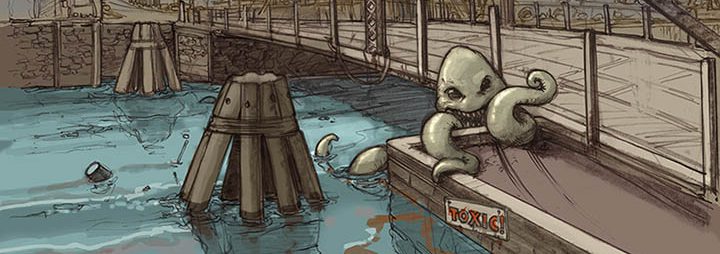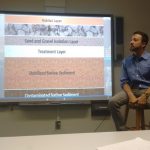Last Thursday on 09/14 we had the author, journalist, historian and a licensed tour guide, Mr. Joseph Alexiou as our guest speaker. Mr. Alexiou, the author of Gowanus: Brooklyn’s Curious Canal, presented in such a way that I felt he was leading a field trip to the Gowanus even when sitting at the library classroom 543! He primarily emphasized on the history of the Gowanus canal and the surrounding neighborhood. In this blog I will focus on two of the fascinating things that Joseph mentioned during the class: the real estate history behind making the canal and the cleaning of the canal.
From the field trip and Joseph’s presentation we came to know that originally there was a tidal estuary which was named Gowanus Creek by the native settlers. Joseph mentioned some of the native groups like Lenape tribe, Canarsee, the Algonian-speaking Delaware Indians who used the creek for transportation, oysters(our guest mentioned that the tasty foot long oysters became so famous, later in 1840 they had their image on the Brooklyn Daily Eagle!), baby whales, crab, fish, etc. During his presentation he often mentioned “All New York stories are real estate stories”. And I think this is so true. These real estate stories started as early as 1639, three years after the Dutch purchased the area near the Gowanus Bay. In the 19th century the Bay was converted to a canal to promote commerce. This canal accommodated 26,000 vessels that ran up and down. Brownstones were placed on barges and shipped through the canal to create what now is famous as the Brownstone Brooklyn. Heavy industries like that of coal gas manufacturing plants, oil refineries, machine shops, chemical plants, and tannery became concentrated in the area. Joseph gave a detailed description on how the canal was planned to be built by several developers like Daniel Richards, David Doughlass and how based on “Follow the money” concept, the plan of Edward C. Litchfield got implemented. I was awestruck to know 3rd Street was actually Litchfield’s driveway! Thus he placed street lamps at a distance of only 50 feet from each other, while the standard is that of 100 feet. Joseph showed us some archival illustrations as well. Speaking of the Dutch (Netherlands meaning low land) we come to the making of the mills. Our guest speaker gave a brief but interesting account of the mill ponds created at the time. He also mentioned the first “skyscraper” of Brooklyn that is the Old Stone House.
The canal was so close to the sea-level that the tides of the bay forced salt water to mix with the fresh water, hence creating a brackish mix of water. However, with the flourishing of the area, there was a need to create a sewage system for the area as well. So the plan that came up is the Combined Sewer System. Combined sewer systems are sewers that are designed to collect rainwater runoff, domestic sewage, and industrial wastewater in the same pipe. Most of the time, combined sewer systems transport all of their wastewater to a sewage treatment plant, where it is treated and then discharged to a water body. Although the combined sewage idea wasn’t a great one in this case, as the only water treatment plant would be throwing the contaminated water into salt water.
As a result of poor sewage and prolonged contamination, the canal has now become the Eerie canal, and has been ill famous as the most polluted canal. Joseph said that in an average the raw sewage that was dumped into the canal is about 400 million gallons and also that the entire bed of the canal has been contaminated with toxic waste. Coal tar, one of the biggest causes of pollution is still under the public pools, parks and houses of the area.
Even in the cleanup process of the canal the well-known “Follow the Money” concept intervened. Instead of declaring Gowanus the federally super funded site, Mayor Bloomberg chose to make private funding for the cleanup. This is primarily because the City would have had to pay a lot more if it was federally funded by the EPA as compensation for polluting it.
The process of dredging the “lavender lake” is debatable. In conclusion, what I understood after Mr. Alexiou’s presentation is that from the early Dutch settlements in the New Amsterdam (New York in 1626) till date, the Gowanus remains a subject undergoing intense study.





